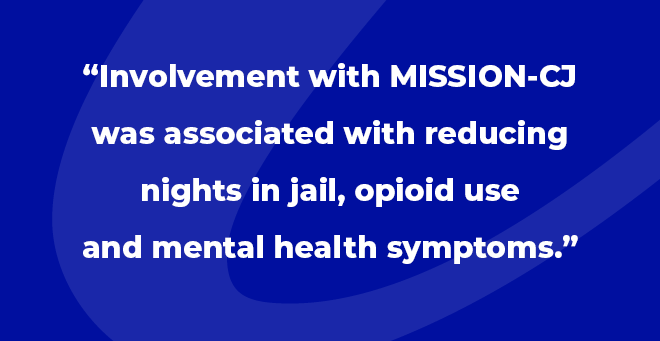An evidence-based wraparound service model that reduces barriers to care was shown to enhance drug treatment courts’ effectiveness in improving criminal justice and behavioral health outcomes among participants with co-occurring mental health and substance use disorders, according to a pilot study led by UMass Medical School researchers.

The study by UMass Medical School authors Paige M. Shaffer, MPH, instructor in psychiatry; Camilo Posada Rodriguez, clinical research assistant; Ayorkor Gaba, PsyD, assistant professor of psychiatry; Jennifer Harter, PhD, senior project director; and David Smelson, PsyD, professor of medicine; with collaborators from Boston University School of Social Work and Massachusetts Executive Office of the Trial Court, was published in April in International Journal of Law and Psychiatry.
Researchers looked at six-month behavioral health and criminal justice outcomes among a hard-to-engage sample of 79 participants in drug treatment courts in Quincy and Chelsea. All participants had co-occurring mental health and substance use disorders. They received a wraparound treatment model, developed by Dr. Smelson and colleagues at UMass Medical School, called MISSION-CJ (Maintaining Independence and Sobriety through Systems Integration, Outreach and Networking-Criminal Justice). Sixty-five participants completed the six-month follow up.
Drug treatment courts are an alternative to incarceration, designed to leverage legal sanctions in exchange for mandatory and court-ordered addiction treatment.
Involvement with MISSION-CJ was associated with reducing nights in jail, opioid use and mental health symptoms over the six-month period. Additional improvements in reducing nights in jail, illicit substance use and opioid use were observed for clients who were highly engaged in adhering to MISSION-CJ.
MISSION-CJ includes the integration of criminogenic risk and needs assessment, risk-need-responsivity informed treatment planning, and materials that promote prosocial thinking and behavior, according to the authors. It is delivered jointly by a case manager and peer support specialist with lived recovery and criminal justice experience. The MISSION-CJ curriculum includes structured sessions, collaboration with drug treatment court teams and unstructured support in the community or even the participant’s home.
Treatment components include critical time intervention case management, dual recovery therapy, peer support, vocational and educational support, trauma-informed care, and a risk-need-responsivity framework.
Shaffer highlighted working with state agencies including the Massachusetts Department of Public Health, Department of Mental Health, Executive Office of the Trial Court and Massachusetts Probation Service as a key factor to engage clients with complex needs.
“It was really this collaborative approach of how you meet someone where they’re at and make sure that they have improved mental health, substance use and other life improvements, like housing and employment,” she said. “Our case manager and peer specialist would go into the courts to go to those weekly meetings, but they’d also be in touch with a probation officer every week. It really almost works seamlessly, like they were part of the team.”
She noted that clients in this sample often “fell through the cracks,” living in unstable housing and averaging well more than a decade of criminal justice involvement, regular illicit substance abuse and mild mental health symptoms. Shaffer said, “Something about that additive portion of having more MISSION-CJ involvement, along with what was happening in the drug court, really improved things for folks.”
“So, the question is, how much is the specialty court affecting outcomes and how much is MISSION-CJ affecting outcomes? We would like to think that it’s the combination of the court and the treatment provider that is improving outcomes,” said Smelson. “Paige’s paper really helped us to justify that it is MISSION that also played an important role in driving improved outcomes. It’s the integration of MISSION with that court.”
Smelson developed the MISSION model 25 years ago to address fragmented health, behavioral health and social service systems and it has been applied nationwide in various settings, including work with veterans and people who are homeless.
“What’s different about MISSION is, when you go to your provider, you get assigned to providers who actually can come out to see you,” he said. “It’s actually bringing treatment to the community and linking people to support, and that’s pretty unique.”
Researchers said future steps would include a randomized trial and a larger sample.
Related stories on UMassMed News:
Federal push for drug courts mirrors the model in Massachusetts
Massachusetts Center of Excellence for Specialty Courts launches website